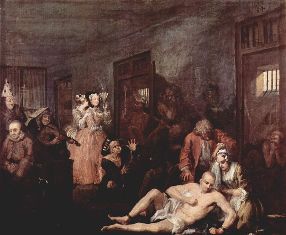
CCO + VAE = Rake²
Tom Rakewell in Stravinsky's opera "The Rake's Progress" does not fit the classic definition of a rake, i.e. libertine, heartless womanizer, etc. He is a lazy ne'er-do-well instead.

When Father Trulove offers Tom a job in anticipation of Tom's marriage to his daughter Anne, Tom demurs, preferring, he says, "to live by my wits" and trust to "the favor of fortune."
Uh oh. Country lad Tom's wits are no match for Nick Shadow, alias the devil, who pops up and offers him a free ride in the form of a sudden bequest by a long-lost uncle. But even when Tom embarks on loose living in the big city, he repeatedly thinks of Anne and regrets what he has done. Tom is even a hero when he confronts and defeats the devil in their game of cards for his soul. He is genuinely sympathetic, too, when, struck insane by Nick, he languishes as Adonis awaiting Venus in Bedlam.
The Cincinnati Chamber Orchestra and the Vocal Arts Ensemble led by CCO music director Mischa Santora, presented a concert version of "The Rake's Progress" Sunday afternoon (March 18) in Corbett Theater at the School for Creative and Performing Arts. It was a semi-staged, fully acted and thoroughly delightful version of Stravinsky's 1951-classic. With a masterful libretto by W.H. Auden and Chester Kallman, the opera was inspired by William Hogarth's well known paintings depicting the ruin of a dissolute young man and by the operas of Mozart.
The 32-piece CCO occupied the left side of the stage, with the action
transpiring on the right and in front of the orchestra. The 23-voice chorus sat
center stage in chairs adjacent to the CCO. Costumes were updated --
Nick Shadow wore black slacks and a shirt, Anne a prim little dress --
with only a table and two chairs for props (Tom's house in London). The
company performed before a changing, solid color background.
Clever updatings included substituting a piece of commercial paper
for Stravinsky's magic bread machine (which turns stones into bread).
The surtitles read "collatoralized debt obligations" and "credit default
swaps" as Tom scattered money over the stage.
The cast was uniformly strong, with tenor Scott Ramsay as Tom, soprano Nadine Sierra as Anne, bass-baritone Gus Andreassen as Nick Shadow and mezzo-soprano Kirstin Chavez as the bearded lady Baba the Turk. Representing the VAE were bass Thom Mariner as Father Trulove, mezzo-soprano Jennifer Trombley as Mother Goose, tenor Andrew Jones as the auctioneer Sellem and bass Jonathan Stinson as Keeper of the Madhouse. The VAE, prepared by music director Donald Nally, portrayed the many and colorful voices of London, including drunks, prostitutes, auction goers and inmates of the insane asylum.
Ramsay's smooth lyric tenor enhanced Tom's sympathetic side, as in his
remorseful aria sung on his knees at Mother Goose's (whore)house and at
the beginning of act II, where he lamented
"the gap in my heart." Most affecting was the final scene, where he and Sierra adopted the same pose used by Hogarth in
his painting of the rake in Bedlam.
Rivera as Anne filled her bright, clear voice with emotion, conveying joy and sorrow, courage and tenderness, as in "Gently, little
boat," the deeply moving lullaby Anne sings to Tom in the asylum.
Andreassen's Nick possessed the most powerful voice. It was overwhelming at times, especially in ensemble pieces, but always
arresting. His "I was never saner," as he urged Tom to embrace freedom and marry Baba the Turk ("Would you be happy? Then learn to act freely.") was a
highlight of the show. No subtle devil, he was a fine actor also,
rubbing his hand with relish after concluding his bargain to "serve" Tom for a year and a day,
and stalking furiously through the blazing red door to hell after losing the card
game with Tom.
The opera's comic ingredient, Baba, was exceeding tasty in Chavez'
rendition. She sang and danced for her fans (the chorus) and
engaged in a hilarious tirade with Tom as he ignored her at breakfast.
Trombley was a singularly seductive Mother Goose, who entices Tom away from
his reverie for Anne.
Mariner as Anne's father, was the image of dignity and paternal
caring, with a bass voice to match. Jones injected considerable
humor into his role as Sellem, and Stinson made a brief, but
memorable appearance as the Keeper of the Madhouse.
The brightest, collective star of the opera was the VAE, who
put energy and invention into their many roles. They could be seen twisting,
grimacing and exhibiting other symptoms of madness in the scene in Bedlam, where they joined Anne in a moving lamentation for Tom.
Expertly led by Santora, who kept an unerring watch on the proceedings, the CCO performed with crispness, character and lyrical polish. Concert opera is an important and extremely successful niche for the orchestra, so much the better when joined by the VAE.